Jobs
People work jobs to earn money (called a salary) which they use to buy things like food, clothes, cars, and houses. Jobs can be classified into three sectors: primary involves obtaining or processing natural products like farming and fishing. Secondary transforms natural products into manufactured goods like manufacturing. Tertiary provides services to people and businesses like retail, healthcare, and banking. Farming involves growing crops and rearing livestock which provides products like meat and milk. Fishing catches fish near coasts or far at sea. Mining extracts natural resources from the earth like coal, stone, and minerals. Manufacturing transforms natural resources into products through crafts using hands or industry using machines. Service jobs provide education, healthcare, tourism, transportation
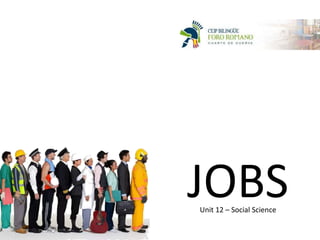
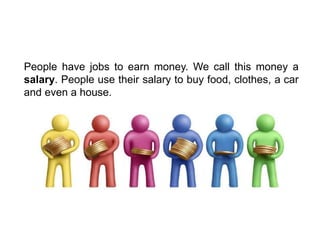

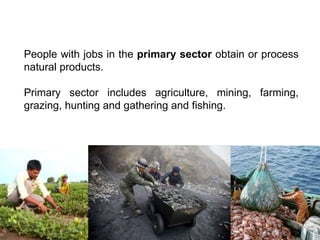

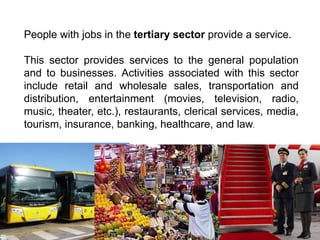
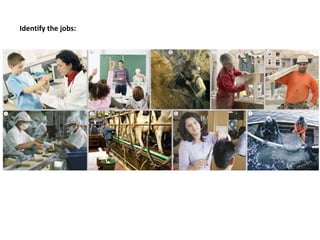
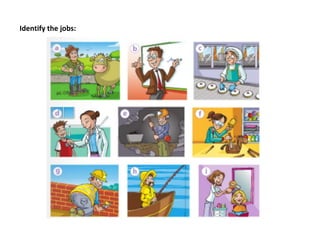
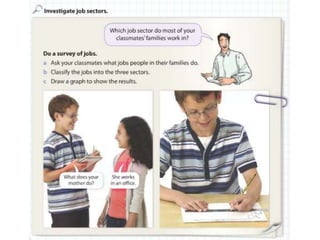
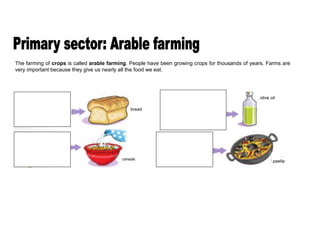

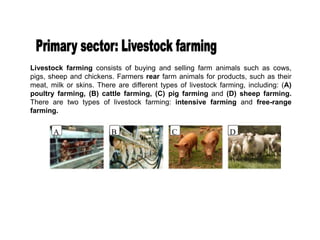

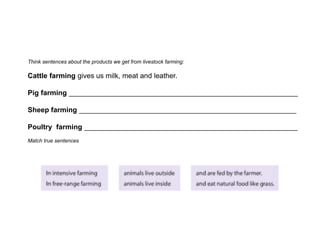
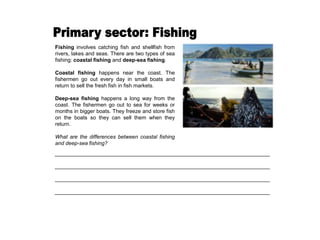

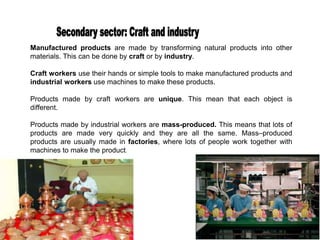
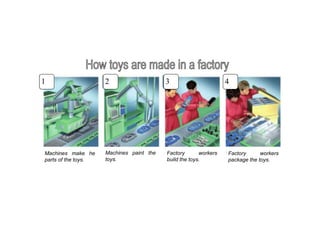
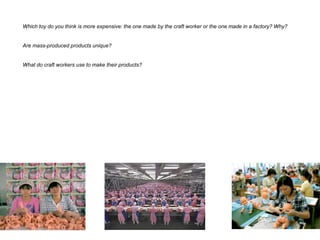

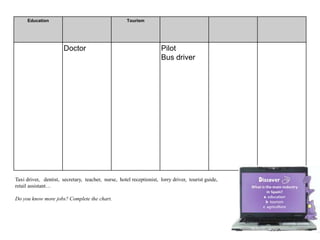
Recommended
More Related Content
Similar to Jobs (20)
More from Ana & Toño Free (13)
Jobs
- 1. JOBSUnit 12 – Social Science
- 2. People have jobs to earn money. We call this money a salary. People use their salary to buy food, clothes, a car and even a house.
- 3. We can classify jobs into three sectors called the primary, secondary and tertiary sectors.
- 4. People with jobs in the primary sector obtain or process natural products. Primary sector includes agriculture, mining, farming, grazing, hunting and gathering and fishing.
- 5. People with jobs in the secondary sector transform natural products into manufactured products. secondary sector includes metal working, automobile production, textile production, chemical and engineering industries, aerospace manufacturing, energy utilities, engineering, breweries and bottlers, construction, and shipbuilding.
- 6. People with jobs in the tertiary sector provide a service. This sector provides services to the general population and to businesses. Activities associated with this sector include retail and wholesale sales, transportation and distribution, entertainment (movies, television, radio, music, theater, etc.), restaurants, clerical services, media, tourism, insurance, banking, healthcare, and law.
- 10. The farming of crops is called arable farming. People have been growing crops for thousands of years. Farms are very important because they give us nearly all the food we eat. bread cereals olive oil paella
- 11. All crops need water to grow, but some crops need just rainwater. We call these crops dry crops. Olive trees, wheat and grapes are some examples of dry crops. Tomatoes, potatoes and rice are some crops that need more water than just rainwater to grow well. These are called irrigated crops. Farmers use irrigation to give these crops the extra water they need. What’s the difference between dry crops and irrigated crops? Complete the chart with these six crops. Grapes Oranges Rice Potatoes Wheat Olives Dry crops Irrigated crops _____________ _______________ ______________ _____________ _______________ ______________
- 12. Livestock farming consists of buying and selling farm animals such as cows, pigs, sheep and chickens. Farmers rear farm animals for products, such as their meat, milk or skins. There are different types of livestock farming, including: (A) poultry farming, (B) cattle farming, (C) pig farming and (D) sheep farming. There are two types of livestock farming: intensive farming and free-range farming. A B C D
- 13. 1 2 3 4 The farmer feeds the cows. The farmer milks the cows. The milk is processed in factories We buy the milk from the shops.
- 14. Think sentences about the products we get from livestock farming: Cattle farming gives us milk, meat and leather. Pig farming __________________________________________________________ Sheep farming _______________________________________________________ Poultry farming ______________________________________________________ Match true sentences
- 15. Fishing involves catching fish and shellfish from rivers, lakes and seas. There are two types of sea fishing: coastal fishing and deep-sea fishing. Coastal fishing happens near the coast. The fishermen go out every day in small boats and return to sell the fresh fish in fish markets. Deep-sea fishing happens a long way from the coast. The fishermen go out to sea for weeks or months in bigger boats. They freeze and store fish on the boats so they can sell them when they return. What are the differences between coastal fishing and deep-sea fishing? _________________________________________________________________________ _________________________________________________________________________ _________________________________________________________________________ _________________________________________________________________________
- 16. Mining involves taking natural resources from the Earth. A miner mines rocks and minerals, such as coal, stone, salt and even gold. This work is hard and can be dangerous. Miners have to work in deep tunnels underground. What natural resources do miners take from the Earth? ________________________________________ Why do you think that mining is a hard work? ______________________________________________________ ______________________________________________________ ______________________________________________________ ______________________________________________________ _________________________________________________________________________
- 17. Manufactured products are made by transforming natural products into other materials. This can be done by craft or by industry. Craft workers use their hands or simple tools to make manufactured products and industrial workers use machines to make these products. Products made by craft workers are unique. This mean that each object is different. Products made by industrial workers are mass-produced. This means that lots of products are made very quickly and they are all the same. Mass–produced products are usually made in factories, where lots of people work together with machines to make the product.
- 18. 1 2 3 4 Machines make he parts of the toys. Machines paint the toys. Factory workers build the toys. Factory workers package the toys.
- 19. Which toy do you think is more expensive: the one made by the craft worker or the one made in a factory? Why? Are mass-produced products unique? What do craft workers use to make their products?
- 20. Many people have jobs that provides a service. We can classify these jobs into different groups, for example: education, health care, tourism, transport, retail and administration. People with jobs in education help us learn new things. People with jobs in health care look after our health and the health of animals, too. People with jobs in tourism help us when we go on holiday. People with jobs in transport take us from one place to another or transport goods. People with jobs in retail help sell products to customers. People with jobs in administration help organise work in offices. Identify the jobs.
- 21. Taxi driver, dentist, secretary, teacher, nurse, hotel receptionist, lorry driver, tourist guide, retail assistant… Do you know more jobs? Complete the chart. Education Tourism Doctor Pilot Bus driver
